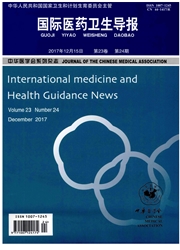

 中文摘要:
中文摘要:
目的探讨B-Lynch缝合术在剖宫产宫缩乏力性产后出血的临床效果。方法138例剖宫产宫缩乏力性产后出血的病例,在处理刮宫产术中出血时,研究组51例应用B-Lynch缝合术,对照组87例采用传统的手术方法。结果研究组手术时间、术中平均出血量、术后24h出血量分别为(33.7±6.2)min、(409.7±28.8)ml与(448.8±20.8)ml,均明显少于对照组的(483±10.4)min、(525.5±41.8)ml及(567.9±31.6)ml(P〈0.05)。所有产妇无腹痛、恶露排出不畅等不良反应,术后40例患者超声检查示子宫复旧好,切口愈合佳,恶露均已净。结论应用B—Lynch缝合术可以有效控制剖宫产产后宫缩乏力引起的出血。
 英文摘要:
英文摘要:
Objective To explore the efficacy of B-Lynch suture for postpartum hemorrhage due to uterine atony during cesarean section, Methoda 138 women with postpartum hemorrhage due to uterine atony were analyzed retrospectively. B-Lynch suture was applied in 51 of the women (study group) and conventional surgery for hemorrhage was performed in another 87 women (control group). The operation time, intraoperative blood loss, and postsurgical bleeding volume were compared between the two groups. Results The mean operation time was shorter and intraoperative blood loss and 24-hour postsurgical bleeding volume were much less in the study group than in the control[(33.7 ± 6.2 ) min vs. ( 48.3±10.4 ) min, ( 409. 7 ± 28.8 ) ml vs. (525.5 ± 41.8 ) ml, and (448.8± 20.8 ) ml vs.( 567.9 ±31.6 ); P〈0.05]. No hypogastralgia and inadequate loehia discharge were found. Ultrasonography showed uterine recovery and incision healing were ideal in all the women. Conclusions B-Lynch suture can effectively control postpartum hemorrhage due to uterine atony during cesarean section.
 同期刊论文项目
同期刊论文项目
 同项目期刊论文
同项目期刊论文
 期刊信息
期刊信息
